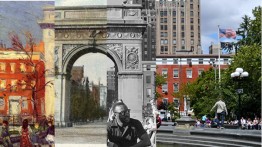The City Transformed: Part II

New York: The City Transformed II
Cost: $300.00
8 Wednesday evenings, March 18 – May 13, 6:30 PM – 8:00 PM, skipping April 8.
This series of eight slide lectures illustrates the historic transformations of New York City. Discover how architectural and engineering innovations—along with human ingenuity—transformed New York into a world-class metropolis.
Barry Lewis’ walking tours of Broadway, 42nd Street, Brooklyn and Harlem, with host David Hartman, were nationally televised on public television. His Broadway walking tour was given 3 ½ stars by The Daily News and was highlighted in The New York Times and TV Guide. Of the series, The New York Post said “…. only Lewis could do it.”
Lecture 1: Beaux-Arts NY / 1890-1925—Skyscrapers and Public Buildings Americans merge Renaissance neo-classicism with Yankee efficiency and practicality to create the modern city. The result is a new class of public building, from the NY Public Library to The Metropolitan Museum that can serve a mass-market democracy. At the same time, we literally stretch neo-classicism to create the world’s first generation of skyscrapers.
Lecture 2: Beaux-Arts NY / 1890-1930—Apartment Houses and Grand Mansions Typical of New York’s rapid change, Gilded Age mansions line Fifth Avenue only to be replaced in a generation by that new form of urban living (at least, to Americans): the apartment building.
Lecture 3: Alternatives to Establishment Beaux-Arts—1890-1930 "Chicago style" skyscrapers, Times Square theaters and Coney Island Wonderlands New York's Beaux-Arts trained architects were more flexible and “modern” than we think. From quirky skyscrapers and functionalist factories to music halls and amusement park fantasies, New York produces creative solutions for the needs of modern living.
Lecture 4: Beaux-Arts NY / 1890-1940—Planned Neighborhoods and Garden Suburbs Today we call them "new urbanist" communities and we think it's a new idea, but a century ago we built planned urban neighborhoods, accessible to rapid transit, with "town centers" for shopping and theaters, community clubhouses for socializing, and gardens, parks and sports facilities for a healthy, outdoor life. Forest Hills Gardens, Jackson Heights and Sunnyside Gardens are among the pioneering new urbanist neighborhoods we’ll be “visiting.”
Lecture 5: Art Deco NY: The 1920's NY Skyscraper and Its European Roots The New York skyline is re-made with legendary Art Deco skyscrapers of 1920s including the Chanin, Chrysler and Empire State Buildings. Their iconic imagery is rooted in predecessors as varied as Germany's expressionist fantasies and our own Woolworth Building.
Lecture 6: Brooklyn and the Bronx in the 1920's New York's urban outer boroughs change dramatically as the offspring of the 19th century's immigrants rise into the middle class, bringing new populations to both Flatbush and Fordham.
Lecture 7: Art Moderne New York: The 1930's NY Skyscraper, from Rockefeller Center to Parkchester Depression-era New York produces two of America’s most interesting urban complexes: the one for commerce, Rockefeller Center and the other for living, Parkchester. We will look at the new shape of 1930’s skyscrapers and the city planning vision of which they become a part.
Lecture 8 Post-World War II NY / 1950-1990 The International Style (the Modern) and the Post-Modern We conclude the series with the glass boxes of the Seagram Building era (1950’s and 60’s), the post-modern of the 1980’s and the revival of New York at the turn of the 21st century.
Registration for this class will open on January 8th.
Course Code: 126668
Instructor(s): Barry Lewis




